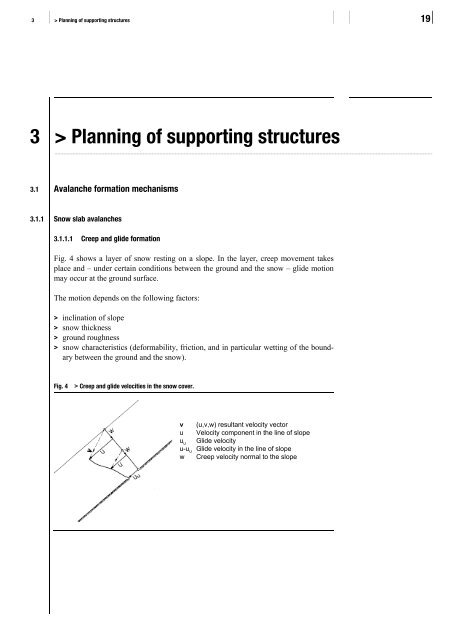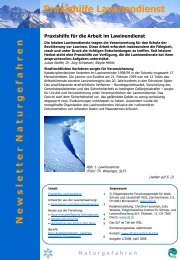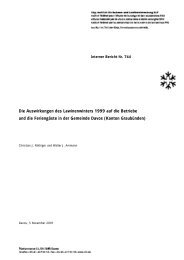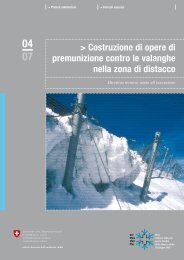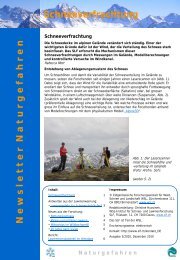Technical Guidel<strong>in</strong>e for <strong>Defense</strong> Structures <strong>in</strong> Avalanche Start<strong>in</strong>g Zones FOEN / WSL 2007 18 Symbol Unit Description Section S'N kN/m' Component of snow pressure <strong>in</strong> the l<strong>in</strong>e of slope (creep and glide pressure) 5.9.7.4.4, 5.9.7.5.5, 7.5.4.4 4.2, 4.3, 4.5, 4.6.1, 5.5.2.1, 5.5.2.2, 5.5.2.4, 5.5.2.5, 5.5.6, 5.7.4.1 S'Q kN/m' Snow pressure component normal to the slope (creep pressure) 4.3, 5.5.2.2, 5.5.2.5, 5.7.4.3 S'R kN/m' Additional snow pressure component <strong>in</strong> the l<strong>in</strong>e of slope at the end of a support<strong>in</strong>g surface (end-effect force) 4.5, 5.5.2.4, 5.5.2.5, 5.6.1.4 SS kN Lateral load of a support<strong>in</strong>g structure (parallel to the contour l<strong>in</strong>e) 4.7, 5.5.6, 5.7.4.3, 5.9.7.3.2 sB kN/m² Ultimate shear resistance <strong>in</strong> the undisturbed ground along the surface of a concrete foundation (tension load) 5.9.5.4, 5.9.6.4 s*B kN/m² Ultimate shear resistance <strong>in</strong> the refilled ground material along the surface of a prefabricated foundation (tension load<strong>in</strong>g) 5.9.6.4 Tk kN Characteristic value of the resultant foundation force imp<strong>in</strong>g<strong>in</strong>g on the upper founda- 5.9.5.3.1, 5.9.5.3.2, 5.9.5.4, 5.9.6.3, tion 5.9.6.4 t m Foundation depth (measured <strong>in</strong> the vertical) 5.9.5.4, 5.9.6.4 Uk kN Characteristic value of the resultant foundation force imp<strong>in</strong>g<strong>in</strong>g on the lower foundation 5.9.4.2, 5.9.6.5, 5.9.6.6 w m Width of open<strong>in</strong>g between members of the grate 5.8.1.3.1, 5.8.2.3.1, 5.8.3.3 Z m a.sl Altitude 3.5.4, 3.10.6 α ° Angle between direction of force and the l<strong>in</strong>e of slope (refers to foundations) 8.9.6.6, 5.9.4.4, 5.9.4.5 δ ° Angle between the support<strong>in</strong>g surface and the plane normal to the slope 4.4, 5.3.2, 5.5.2.3, 5.6.1.2, 5.8.1.2.1 γM - Coefficient of resistance 5.2.2.1, 5.2.2.2, 5.2.2.4, 5.2.3.2, 5.2.3.3, 5.9.4.1, 5.9.7.1.8 γQ - Load coefficient for variable action 5.2.2.1, 5.2.3.1, 5.9.4.1, 5.9.7.1.8 ε ° Angle between the snow pressure result<strong>in</strong>g from S'N and S'Q (vectorial addition) and the l<strong>in</strong>e of slope 4.3, 5.5.2.2, εR ° Angle between the resultant of all snow pressure forces and the l<strong>in</strong>e of slope 5.5.2.6, 5.6.1.2, 5.8.1.2.1 εcs % Change <strong>in</strong> length (shr<strong>in</strong>kage) of anchor grout 6.2.1.4 η - Influence factor of a support<strong>in</strong>g structure <strong>in</strong> regard to snow pressure 4.6.1, 4.6.2, 5.5.4 ρH t/m³ Average density of snow correspond<strong>in</strong>g to snow height Hext 3.10.2, 5.5.2.1, 5.5.3.4 ρh t/m³ Average density of snow correspond<strong>in</strong>g to snow height h 5.5.3.4 ρ t/m³ General average density of snow 3.10.1, 4.2, 4.4, 5.7.4.4 σα kN/m² Specific total ground resistance 5.9.5.3.1, 5.9.4.4, 5.9.6.5 σ90° kN/m² Total ground resistance normal to the slope 5.9.4.4, 5.9.4.6 σΟ kN/m² Total ground resistance <strong>in</strong> the l<strong>in</strong>e of slope 5.9.4.4 ϕ ° Angle of friction for glide motion of snow over the ground 3.7.2.1, 3.7.2.2, 3.7.2.3 ϕEk ° Characteristic angle of friction for transfer of pressure forces (applies to foundations) 5.9.5.4, 5.9.6.4, 5.9.6.6 ψ ° Incl<strong>in</strong>ation of slope 3.5.3, 4.2, 4.3, 4.4, 5.5.2.2, 5.5.2.3, 5.9.4.4, 8.2.1
3 > Plann<strong>in</strong>g of support<strong>in</strong>g <strong>structures</strong> 19 3 > Plann<strong>in</strong>g of support<strong>in</strong>g <strong>structures</strong> 3.1 Avalanche formation mechanisms 3.1.1 Snow slab <strong>avalanche</strong>s 3.1.1.1 Creep and glide formation Fig. 4 shows a layer of snow rest<strong>in</strong>g on a slope. In the layer, creep movement takes place and – under certa<strong>in</strong> conditions between the ground and the snow – glide motion may occur at the ground surface. The motion depends on the follow<strong>in</strong>g factors: > <strong>in</strong>cl<strong>in</strong>ation of slope > snow thickness > ground roughness > snow characteristics (deformability, friction, and <strong>in</strong> particular wett<strong>in</strong>g of the boundary between the ground and the snow). Fig. 4 > Creep and glide velocities <strong>in</strong> the snow cover. v (u,v,w) resultant velocity vector u Velocity component <strong>in</strong> the l<strong>in</strong>e of slope uu Glide velocity u-uu Glide velocity <strong>in</strong> the l<strong>in</strong>e of slope w Creep velocity normal to the slope


